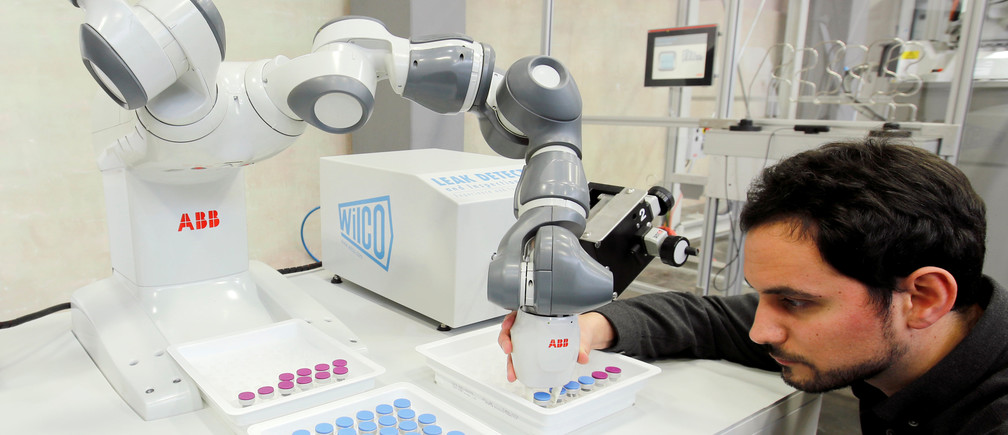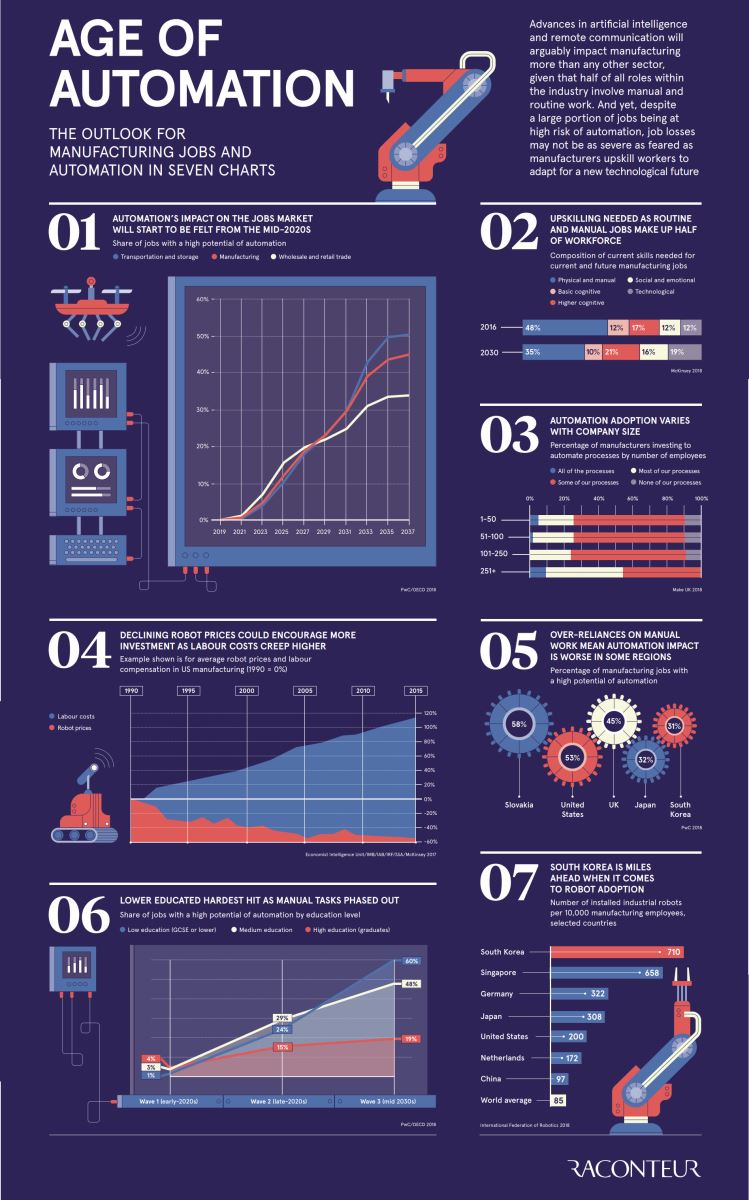-
 7 charts on the future of automation01/03/2019Over the last decade, the prospect of mass automation has seemingly shifted from a vague possibility to an inescapable reality.
7 charts on the future of automation01/03/2019Over the last decade, the prospect of mass automation has seemingly shifted from a vague possibility to an inescapable reality.
While it’s still incredibly difficult to estimate the ultimate impact of automation and AI on the economy, the picture is starting to become a bit clearer as projections begin to converge.

Today’s infographic comes to us from Raconteur, and it highlights seven different charts that show us how automation is shaping the world – and in particular, the future outlook for manufacturing jobs.
The Age of Automation
The precise details are up to debate, but here are a few key areas that many experts agree on with respect to the coming age of automation:
Half of manufacturing hours worked today are spent on manual jobs.
- In an analysis of North American and European manufacturing jobs, it was found that roughly 48% of hours primarily relied on the use of manual or physical labor.
- By the year 2030, it’s estimated that only 35% of time will be spent on such routine work.
Automation’s impact will be felt by the mid-2020s.
- According to a recent report from PwC, the impact on OECD jobs will start to be felt in the mid-2020s.
- By 2025, for example, it’s projected that 10-15% of jobs in three sectors (manufacturing, transportation and storage, and wholesales and retail trade) will have high potential for automation.
- By 2035, the range of jobs with high automation potential will be closer to 35-50% for those sectors.
Industrial robot prices are decreasing.
- Industrial robot sales are sky high, mainly the result of falling industry costs.
- This trend is expected to continue, with the cost of robots falling by 65% between 2015 and 2025.
- With the cost of labor generally rising, this makes it more difficult to keep low-skilled jobs.
Technology simultaneously creates jobs, but how many?
- One bright spot is that automation and AI will also create jobs, likely in functions that are difficult for us to conceive of today.
- Historically, technology has created more jobs than it has destroyed.
- AI alone is expected to have an economic impact of $15.7 trillion by 2030.
Unfortunately, although experts agree that jobs will be created by these technologies, they disagree considerably on how many. This important discrepancy is likely the biggest x-factor in determining the ultimate impact that these technologies will have in the coming years, especially on the workforce.
Nguồn: WEF
-
 Targets in digital society development to 202504/05/2024Implementing the “National Digital Transformation Programme to 2025, with a vision to 2030”, Vietnam has to date attained remarkable achievements, with awareness about digital transformation constantly improving.
Targets in digital society development to 202504/05/2024Implementing the “National Digital Transformation Programme to 2025, with a vision to 2030”, Vietnam has to date attained remarkable achievements, with awareness about digital transformation constantly improving. -
 Four priorities in digital transformation18/07/2023Prime Minister Pham Minh Chinh has outlined four priorities for Vietnam’s digital transformation: developing databases, promoting online public services, developing digital infrastructure and platforms, and ensuring cyber security and information safety.
Four priorities in digital transformation18/07/2023Prime Minister Pham Minh Chinh has outlined four priorities for Vietnam’s digital transformation: developing databases, promoting online public services, developing digital infrastructure and platforms, and ensuring cyber security and information safety. -
 Top 10 Technology Trends in 2023 and Beyond03/01/2023Are you ready to shape your business’ future? Discover the top 10 technology trends in 2023 and beyond in this downloadable infographic.
Top 10 Technology Trends in 2023 and Beyond03/01/2023Are you ready to shape your business’ future? Discover the top 10 technology trends in 2023 and beyond in this downloadable infographic. -
 10 Factors That Make Perfect Digital Transformation14/04/2022Digital Transformation (DX) has been the buzzword around and is now coming to the forefront. One such demand for DX efforts came in the form of the COVID-19 crisis, which brought about a significant change in the way companies function.
10 Factors That Make Perfect Digital Transformation14/04/2022Digital Transformation (DX) has been the buzzword around and is now coming to the forefront. One such demand for DX efforts came in the form of the COVID-19 crisis, which brought about a significant change in the way companies function. -
 10 reasons why AI can boost your e-commerce business30/12/2020Artificial Intelligence (AI) is no longer a concept limited just to sci-fi movies. With recent leaps in Technology, AI has evolved immensely, permeating into every aspect of modern business and society. Now, AI has a bearing on every conceivable thing, from smart-homes and self-driving cars, to the vast domains of e-learning and e-commerce, AI is in everything and everywhere.
10 reasons why AI can boost your e-commerce business30/12/2020Artificial Intelligence (AI) is no longer a concept limited just to sci-fi movies. With recent leaps in Technology, AI has evolved immensely, permeating into every aspect of modern business and society. Now, AI has a bearing on every conceivable thing, from smart-homes and self-driving cars, to the vast domains of e-learning and e-commerce, AI is in everything and everywhere.


